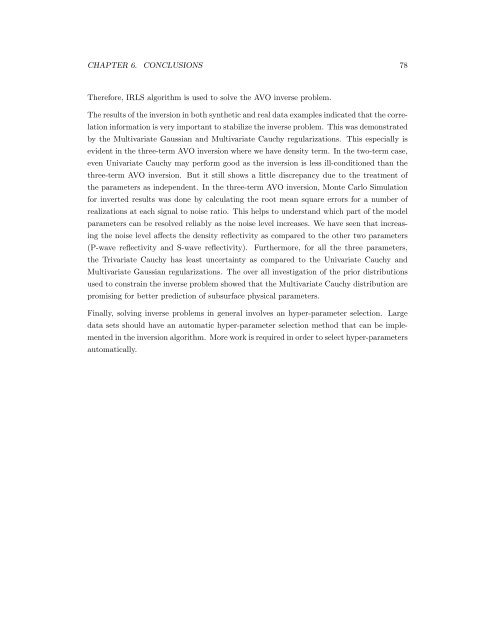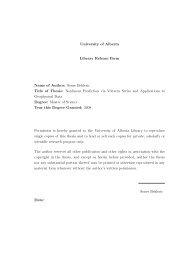Regularization of the AVO inverse problem by means of a ...
Regularization of the AVO inverse problem by means of a ...
Regularization of the AVO inverse problem by means of a ...
You also want an ePaper? Increase the reach of your titles
YUMPU automatically turns print PDFs into web optimized ePapers that Google loves.
CHAPTER 6. CONCLUSIONS 78<br />
Therefore, IRLS algorithm is used to solve <strong>the</strong> <strong>AVO</strong> <strong>inverse</strong> <strong>problem</strong>.<br />
The results <strong>of</strong> <strong>the</strong> inversion in both syn<strong>the</strong>tic and real data examples indicated that <strong>the</strong> corre-<br />
lation information is very important to stabilize <strong>the</strong> <strong>inverse</strong> <strong>problem</strong>. This was demonstrated<br />
<strong>by</strong> <strong>the</strong> Multivariate Gaussian and Multivariate Cauchy regularizations. This especially is<br />
evident in <strong>the</strong> three-term <strong>AVO</strong> inversion where we have density term. In <strong>the</strong> two-term case,<br />
even Univariate Cauchy may perform good as <strong>the</strong> inversion is less ill-conditioned than <strong>the</strong><br />
three-term <strong>AVO</strong> inversion. But it still shows a little discrepancy due to <strong>the</strong> treatment <strong>of</strong><br />
<strong>the</strong> parameters as independent. In <strong>the</strong> three-term <strong>AVO</strong> inversion, Monte Carlo Simulation<br />
for inverted results was done <strong>by</strong> calculating <strong>the</strong> root mean square errors for a number <strong>of</strong><br />
realizations at each signal to noise ratio. This helps to understand which part <strong>of</strong> <strong>the</strong> model<br />
parameters can be resolved reliably as <strong>the</strong> noise level increases. We have seen that increas-<br />
ing <strong>the</strong> noise level affects <strong>the</strong> density reflectivity as compared to <strong>the</strong> o<strong>the</strong>r two parameters<br />
(P-wave reflectivity and S-wave reflectivity). Fur<strong>the</strong>rmore, for all <strong>the</strong> three parameters,<br />
<strong>the</strong> Trivariate Cauchy has least uncertainty as compared to <strong>the</strong> Univariate Cauchy and<br />
Multivariate Gaussian regularizations. The over all investigation <strong>of</strong> <strong>the</strong> prior distributions<br />
used to constrain <strong>the</strong> <strong>inverse</strong> <strong>problem</strong> showed that <strong>the</strong> Multivariate Cauchy distribution are<br />
promising for better prediction <strong>of</strong> subsurface physical parameters.<br />
Finally, solving <strong>inverse</strong> <strong>problem</strong>s in general involves an hyper-parameter selection. Large<br />
data sets should have an automatic hyper-parameter selection method that can be imple-<br />
mented in <strong>the</strong> inversion algorithm. More work is required in order to select hyper-parameters<br />
automatically.









